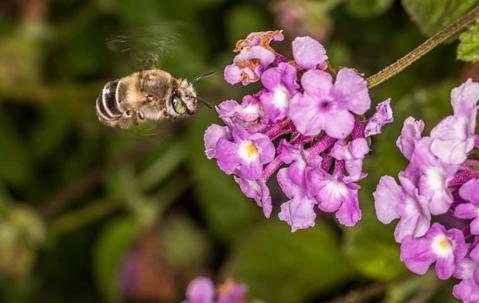Apis Mellifera, popularly known as honey bees, are environmentally friendly creatures and crucial pollinators. Did you know fermented honey, also called Mead,- is the most ancient fermented beverage? The term “honeymoon” is derived from the Norse practice of consuming huge tons of Mead during the initial days of marriage. Did you know that honey bees are projected to pollinate one-third of all the food crops we eat? For over centuries, beekeepers have raised honey bees, harvesting the sweet honey they make and relying on them to pollinate crops. We being one of the most trusted home pest control companies in San Antonio, Texas, have brought you ten interesting facts about these buzzing young naturalists.
1. Honey Bees Fly Between 15-20 Miles per Hour
Since honeybees fly at speeds of 15-20 miles per hour, they are not the fastest fliers in the insect world. They’re built for short trips as they fly from one flower to another. Their tiny wings flap 12,000 to 15,000 times per minute to propel their bodies uphill for a flight to the hive.
2. A Bee Colony Contains Up to 60,000 Bees
Bees are incredibly hardworking insects, and it takes 20,000 to 60,000 bees in the hive to get the work done. Below are some of their chores:
- Nurture bees and take care of the young ones.
- The queen’s helper workers bathe and feed her.
- Shield other bees and watch over the hive.
- Construction worker bees make the beeswax foundation for the queen to lays eggs and the workers to stock honey.
- Undertakers evacuate the dead and further clean any mess in the hive.
- Foragers bring sufficient pollen and nectar to nourish the entire community.
3. A Single Worker Bee Makes .083 of a Teaspoon of Honey.
From spring to fall, worker bees ensure they produce about 60 pounds of honey for the whole colony to survive in the winters. Each worker makes about .083 teaspoons of honey.
4. Queen Honey Bees Stock up a Life Span Supply of Sperms
The queen bee lives for three to five years; if she doesn’t mate within 20 days, she loses her aptitude. If she does mate, however, the queen never needs to mate again. Instead, she preserves the sperm in her spermatheca and uses it to fertilize eggs throughout her life.
5. A Queen Honey Bee Can Lay Over 2,000 Eggs Daily
Just 48 hours after mating, the queen starts to lay eggs. In one single day, a queen bee lays about 1,500 eggs, and over the period, she can lay around 1 million eggs. Hence, attendant workers are needed to take care of the queen’s grooming/ feeding needs.
6. Honey Bees Use Symbolic Lingo
Honeybees converse in the most complex symbolic language. They pack a million neurons into a brain that measures a simple cubic millimeter, and they use each one of them. Worker bees perform various roles throughout their life. For example, foragers find flowers, find food sources, navigate back home, and share detailed data about their findings with other bees. Then, they convey this information with hive mates through an intricately choreographed dance.
7. Drones Die Instantly After Mating
Male honey bees, called drones, can only provide sperm to the queen. After a week of maturing from their cells, drones are ready to mate. After they’ve mated, they die immediately.
8. A Beehive is 93° Fahrenheit Throughout
Bees build a strong club within their hive to keep them warm. Workers gather around the queen, insulating her from the cold. In summer, workers fan the air with their wings inside the hive, keeping the brood from overheating.
9. Beeswax Comes From a Bee’s Belly
Workers build the honeycomb by collecting beeswax from younger worker bees. Eight paired glands of their abdomen produce wax droplets, which solidify into flakes. The worker bees then work the wax flakes in their jaws to soften them into a malleable structure.
10. A Worker Bee Visits 2000 Flowers Daily
A teenage worker bee cannot collect pollen all at once from many flowers; therefore, she visits 50 to 100 flowers per day. She does several round trips daily, foraging forays during the day, which makes her tired. A hardworking forager can stay up to 3 weeks and cover 500 miles.
If you are looking for the best pest control company in San Antonio, look no further. Besides, if you have irritating bees in your backyard, we will help you with safe bee removal in San Antonio.

